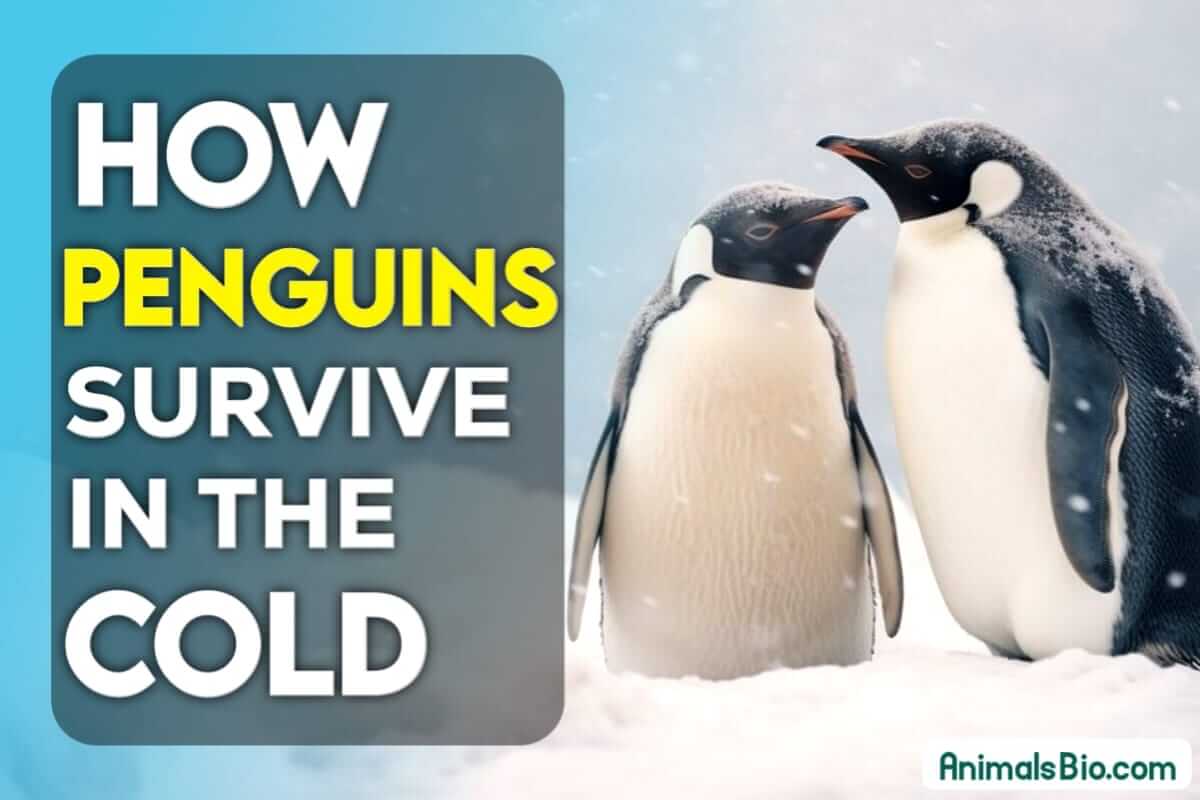One of the most fascinating aspects of the natural world is the ability of wildlife to adapt to its surroundings. A prime example of this remarkable adaptability can be found in penguins, especially those that inhabit the frigid environments of Antarctica.
Despite the relentless, bone-chilling cold, these penguins do more than just survive—they flourish. How do these charming, tuxedo-clad creatures achieve this? The answer lies in their incredible biological adaptations.
These adaptations include a thick layer of insulating fat and a unique feather structure that provides warmth and waterproofing, allowing them to maintain their body heat in extremely low temperatures.
In this article, we will delve deeper into the intriguing world of penguins to uncover how their unique characteristics enable them to thrive in one of the harshest climates on our planet.
How do Penguins Survive in the Cold
Penguins are remarkably well-adapted to survive in cold environments, particularly those species that inhabit the icy regions of Antarctica. Here are some of the key adaptations that enable penguins to thrive in such frigid conditions:
Thick Feathers:
Penguins are equipped with an exceptionally thick layer of feathers that plays a crucial role in their survival in the harsh conditions of their natural habitat. This dense layer not only provides substantial insulation but also features feathers that are tightly packed and overlap one another.
This strategic arrangement forms an effective waterproof barrier, protecting the penguins from the cold and wet conditions prevalent in areas like Antarctica.
This feather structure ensures that their skin remains dry and their body heat is retained, allowing them to thrive in extreme temperatures where other species might struggle to survive.
Layer of Fat:

Beneath their waterproof feathers, penguins possess a thick layer of fat, commonly referred to as blubber, which is vital for their survival in extremely cold environments.
This layer of fat serves as a powerful insulator, helping to retain body heat and maintain a stable internal temperature. This insulation is crucial, especially in the icy waters and frigid air of regions like Antarctica.
The blubber not only protects them from the cold but also provides energy reserves during periods when food is scarce. This adaptation is a key factor that enables penguins to thrive in some of the most inhospitable climates on Earth.
Countercurrent Heat Exchange:
Penguins have developed a sophisticated mechanism called countercurrent heat exchange to minimize heat loss in their extreme environment. This system is an integral part of their circulatory process, where warm blood that flows to the extremities passes closely by the cold blood returning to the heart.
As these streams of blood travel in opposite directions, heat from the warmer blood is transferred to the colder blood. This process ensures that the heat is retained within the body rather than being lost to the surrounding cold environment.
This efficient heat exchange enables penguins to maintain their body temperature and conserve energy, which is essential for their survival in the frigid temperatures of places like Antarctica.
Suggested Article : Why do Owls Hoot at Night ?
Huddling Behavior:
To combat the extreme cold, particularly during harsh storms or the coldest parts of winter, penguins often engage in a behavior known as huddling. This group behavior is crucial for their survival, as it significantly reduces heat loss.
By gathering closely together, penguins share body warmth, effectively conserving heat. The individuals on the outer edges rotate to the center over time, ensuring that each penguin has a chance to warm up at the core of the huddle.
Emperor penguins are especially known for this behavior, which is vital during the breeding season when temperatures are at their most brutal. This communal survival strategy not only helps maintain their body temperature but also strengthens social bonds among the group.
Physical Structure:

Penguins are uniquely designed with a compact and robust body shape that plays a crucial role in their ability to withstand the cold. This streamlined form minimizes the surface area exposed to the harsh environment relative to their body volume, which significantly reduces heat loss.
Such a body design is particularly effective in retaining warmth and conserving energy. Moreover, the adaptations extend to their flippers and feet, which are crucial extremities that could potentially lose a lot of heat. Penguins’ flippers and feet are equipped with special adaptations that minimize heat loss.
The blood vessels in these areas are arranged in a way that reduces the temperature of the blood flowing into the limbs, thereby conserving heat in the core body where it is most needed.
This arrangement ensures that despite spending extended periods in icy waters or on frozen land, penguins maintain their body heat effectively. This combination of physical and physiological traits enables them to thrive in some of the coldest environments on Earth.
Suggested Article : Bald Eagle Lifespan – Interesting Facts
Behavioral Adaptations:
Penguins have developed several behavioral adaptations that help them manage the extreme conditions of their habitats. One key strategy involves their activity patterns.
Penguins are typically more active during the sunnier parts of the day when temperatures are slightly warmer and sunlight is available.
This not only helps them conserve energy but also allows them to take full advantage of the warmer conditions for foraging and social interactions. Additionally, penguins use their body positioning to maximize heat absorption.
During colder periods, they orient themselves towards the sun, leveraging their dark plumage to absorb more heat. The dark feathers efficiently capture solar energy, increasing the penguins’ body temperature and providing essential warmth.
This behavior is crucial during the frigid Antarctic winters, where every bit of heat is vital for survival. These adaptations, both behavioral and physical, are fine-tuned to help penguins thrive in some of the most challenging climates on the planet.
Conclusion
penguins are remarkable creatures that have expertly adapted to survive and thrive in some of the coldest environments on Earth.
Their survival is supported by a combination of physical adaptations, such as thick insulating feathers, a layer of blubber for warmth, and a compact body shape that minimizes heat loss.
Additionally, their behavioral strategies, including huddling to conserve heat, being active during warmer periods of the day, and orienting themselves to maximize sunlight absorption, further demonstrate their incredible ability to manage life in extreme conditions.
These adaptations not only highlight the resilience of penguins but also underscore the intricate balance of life within the ecosystems of the harsh Antarctic region.
Sources :
Cool Antarctica
Wikipedia
Frequently Asked Questions (FAQ)
Why do Penguins live in the Cold ?
Penguins live in cold environments because they are highly adapted to these conditions. Their thick layer of blubber, dense feathers, and behaviors like huddling and sun orientation allow them to thrive where few other species can survive.
What do Penguins Eat ?
Penguins primarily eat a variety of seafood. Their diet consists mainly of fish, krill, and squid. These items provide the necessary nutrients and energy penguins need to survive in their harsh, cold habitats.
Where do Penguins live ?
Penguins primarily live in the Southern Hemisphere. The majority are found in Antarctica, but they also inhabit coastal regions and islands of southern Africa, South America, Australia, and New Zealand. Some species are found as far north as the Galápagos Islands, near the equator.
Why can’t Penguins Fly ?
Penguins can’t fly because their bodies have adapted to their aquatic environment rather than air. They have dense bones that make them less buoyant and better suited for swimming.
Their wings have evolved into flippers, ideal for efficient movement in water but not for flight. These adaptations enable penguins to excel in their marine habitat, catching prey and avoiding predators, while sacrificing the ability to fly.
How Tall are Penguins ?
Penguin heights vary across species, ranging from the small Little Blue Penguin at about 13 inches (33 cm) tall to the larger Emperor Penguin, which can stand up to 48 inches (122 cm) tall.
How long do Penguins live ?
The lifespan of penguins varies by species. On average, penguins live between 15 to 20 years in the wild. Some species, like the Emperor Penguin, can live up to 20 years, while smaller species like the Little Blue Penguin typically live around 6 to 10 years. In captivity, with optimal care, some penguins can live longer than their typical lifespan in the wild.






